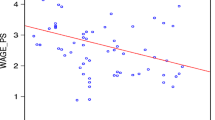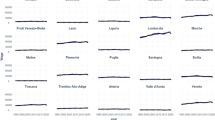Abstract
This paper analyzes wage elasticities using a panel dataset of 2800 large Belgian firms over the period 1987–1994. We explore various functional forms and find that the short-run wage elasticity varies between −0.37 and −0.65, while the long-run elasticity is robustly estimated to be larger than 1 in absolute value. These results are striking for they are much higher than those reported in previous studies using macroeconomic time-series data. This suggests that labour costs are more important in determining the demand for labour than initially was believed.
Similar content being viewed by others
REFERENCES
Arellano, M. and S. Bond (1991), 'Some Tests of Specifications of Panel Data: Monte Carlo Evidence and an Application to Employment Equations,' Review of Economic Studies, 58, pp. 277–294.
Bossier, F., Th. Brecget, M. Englert, M. Saintrain, C. Streel, and F. Vanhorebeek (1995), 'Simulaties betreffende een vermindering van de werkgeversbijdragen voor de sociale zekerheid en vormen van alternatieve financiering,' Planning Paper 75, Federaal Planbureau.
Card, D (1990), 'Unexpected Inflation, Real Wages and Employment Determination in Union Contracts,' American Economic Review, 80, pp. 669–688.
Davis, S. and J. Haltiwanger (1992), 'Gross Job Creation, Cross Job Destruction and Employment Reallocation,' Quarterly Journal of Economics, 106, pp. 819–863.
De la Croix, D., F. Palm, G. Pfann (1996), 'A Dynamic Contracting Model for Xages and Employment in Three European Countries,' European Economic Review, 40, pp. 429–449.
Drèze, J. and F. Modigliani (1981), 'The Trade-off Between Real Wages and Employment in an Open Economy (Belgium),' European Economic Review, 15, pp. 1–40.
Freeman, R. (1995), 'The Limits of Wage Flexibility to Curing Unemployment,' Oxford Review of Economic Policy, 11, pp. 63–72.
Goubert, L., F. Heylen, and E. Omey (1995), 'De werkloosheidsverzekering,' in: M. Despontin, and M. Jegers (eds.), De sociale zekerheid verzekerd?, VEV, VUB press.
Hamermesh, D.S. (1993), Labor Demand, Princeton, Princeton University Press.
Konings, J. (1995), 'Gross Job Creation and Gross Job Destruction in the UK Manufacturing Sector,' Oxford Bulletin of Economics and Statistics, 57, pp. 5–25.
Layard, R. and S. Nickell, 'Unemployment in Britain,' Economica, 53, S121–S170.
Lockwood, B. and A. Manning (1989), 'Dynamic Wage-Employment Bargaining with Employment Adjustment Costs,' Economic Journal, 99, pp. 1143–1158.
Manning, A. (1987), 'An Integration of Trade Union Models in a Sequential Bargaining Framework,' Economic Journal, 97, pp. 121–139.
Meeusen, W. and G. Rayp (1995), 'Sociale zekerheid en concurrentievermogen,' in: M. Despontin, and M. Jegers (eds.), De sociale zekerheid verzekerd?, VEV, VUB press.
Mortensen, D. and C. Pissarides (1995), 'Technological Progress and the Process of Job Creation and Destruction,' Centre for Economic Performance, Discussion Paper, London School of Economics.
Nickell, S. (1986), 'Dynamic Models of Labour Demand,' in: O. Ashenfelter, and R. Layard (eds.), Handbook of Labor Economics, chapter 9.
Nickell, S. and S. Wadhwani (1991), 'Employment Determination in British Industry: Investigations Using Micro Data,' Review of Economic Studies, 58, pp. 955–969.
Pfann, G.A. and F.C. Palm (1993), 'Asymmetric Adjustment Costs in Non-linear Labour Demand Models for The Netherlands and UK Manufacturing Sectors,' Review of Economic Studies, 60, pp. 397–412.
Author information
Authors and Affiliations
Rights and permissions
About this article
Cite this article
Konings, J., Roodhooft, F. How Elastic is the Demand for Labour in Belgian Enterprises?Results from Firm Level Accounts Data, 1987–1994. De Economist 145, 229–241 (1997). https://doi.org/10.1023/A:1002994205321
Issue Date:
DOI: https://doi.org/10.1023/A:1002994205321




